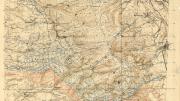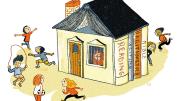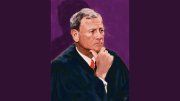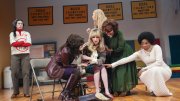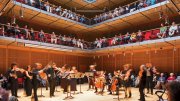It is a good thing that Harvard’s campus was not sundered this past fall semester (as it was in 2023) by bitter, despairing, and even hateful divisions over terrorism and the brutal war in the Middle East. But the protests that have occurred most often of late—quiet “study-ins” at various libraries—have diminished the University, with people mutually mistaking minor matters for major ones and accordingly playing for small stakes.
The stage may have been set in emails last August, detailing rules for use of campus spaces, from executive vice president Meredith Weenick. There was administrative logic to the authorship (she oversees all campus services, including safe, legal use of the premises), but the choice seemed wooden in light of heightened concerns about freedom of speech and possible restrictions thereon. Putting a fundamental University value on the same level as, say, the procedure for reserving an event space seems a clear category error. Given many professors’ doubts about Harvard governance and leadership—highly individualistic scholars are debating whether to join forces in a University-wide faculty senate—this was a textbook case of waving a red cape in front of a cranky bull.
Earlier, the January 19, 2024, announcement by (then interim) President Alan M. Garber and the deans on the University-wide Statement of Rights and Responsibilities (see “Own Goals,” September-October 2024, page 5) specified that “demonstrations and protests are ordinarily not permitted in…spaces of instruction; libraries or other spaces designated for study…; dormitories, residence halls, or dining halls…; offices where the work of the University is carried out; or other places in which demonstrations and protests would interfere with the normal activities of the University.” But the list of places off-limits for protest, and the accompanying categories of forbidden activities (blocking freedom of movement, interfering with freedom from personal force or violence), necessarily leave plenty of ground for interpretation about what constitutes interference or a true disruption—and plenty of room for unintended consequences.
Harvard makes much of its professors’ and students’ entrepreneurial prowess. Unsurprisingly, that knack extends to finding ways to express themselves and to probe for institutional weaknesses. Cue the bullfight.
On multiple occasions this fall, pro-Palestinian students have organized themselves to go to a library reading room together and to display, in their dress and with signage, support for their cause (see “‘Study-Ins’ and Studying,” this issue, page 13). During the initial Widener protest, the library’s response was to notify students that they were violating policy, have security personnel collect ID information from those who failed to disperse, and then withhold physical access to Widener for two weeks. Faculty members who staged a similar demonstration in support of the students got the same treatment.
These actions were organized protests or demonstrations: clearly proscribed. Thus, some sanction would necessarily ensue, lest the perpetrators undercut orderly governance. But that begs the real question: apart from the commotion caused by security personnel warning the protesters and collecting IDs, how were other patrons’ academic pursuits knocked off-kilter? As a November 13 Crimson editorial headlined, “Whether Study-Ins Are Protests Doesn’t Matter. Whether They’re Disruptive Does”—a blanket condemnation of Harvard’s policies and punishments in these cases.
Consider a thought experiment: If a few dozen students had joined together last November 4 and entered Widener wearing buttons that read “Kamala = Communist” or “Trumpism Is Fascism,” would their partisan act have been tolerated? (And if not, what does that say about the fiber of Harvard students exposed to others’ differing opinions?) The segue from defining speech via place-based rules to punishing silent, if organized, pro-Palestinian advocacy seems, charitably, another category error.
Defending free speech requires challenging procedures that don’t make sense. In response to Harvard’s ban on sidewalk chalking, faculty members broke the rule and the Faculty of Arts and Sciences then intelligently modified its applicability to its own facilities. The library protests may be viewed as a similar attack on administrative pettifoggery. That they have now become a preoccupation of University leaders, who weighed in against the protests on November 4, and the subject of the FAS dean’s extended remarks at the November 5 faculty meeting (see harvardmag.com/state-of-fas-24), suggests that the rules are producing unintended consequences and vulnerabilities—and so have become more of a problem than the community’s discourse per se. As a further result, Harvard’s leaders continue to focus on lesser matters (perhaps from fear of external critics’ desire to repress protests, at least of this flavor), rather than on articulating academic priorities.
The ultimate stakes, of course, are the substantive concerns: making room for speech that may irritate, or actually infuriate, people who hold other views (see the review of Freedom for the Thought That We Hate: A Biography of the First Amendment, by the late Anthony Lewis ’48, NF ’57, May-June 2008). On these grounds, this autumn’s protests themselves are small beer. Against the backdrop of decades of Middle East strife, the latest bloodshed, with its shocking civilian toll initially in Israel and now in Gaza, Lebanon, and beyond, continues. Differing views on those horrific issues beg to be addressed directly through substantive teach-ins or further organizing in the public square: attempts to educate a polarized polity or influence policy. Instead, the discourse has been turned inward and reduced to a whack-a-mole contest of wills about University rulemaking. This is a form of category error, too: civil disobedience calculated to annoy the University brass—no doubt gratifying to people of a certain turn of mind, but vanishingly unlikely to make a real difference to those who are suffering.
If the protesters want to address those issues and highlight their larger speech concerns, maybe they could apply to stage events in all the officially approved times, places, and manners, to see whether Harvard’s procedures and rules apply fairly and neutrally, and to use those occasions to make their case about the matters of life and death facing those in the war zone. In both senses, those would be the highest stakes for Harvard—clarifying not only the bounds of speech within this community, but also the purposes to which that speech can usefully be put—after a year of dismaying failures.
—John S. Rosenberg
